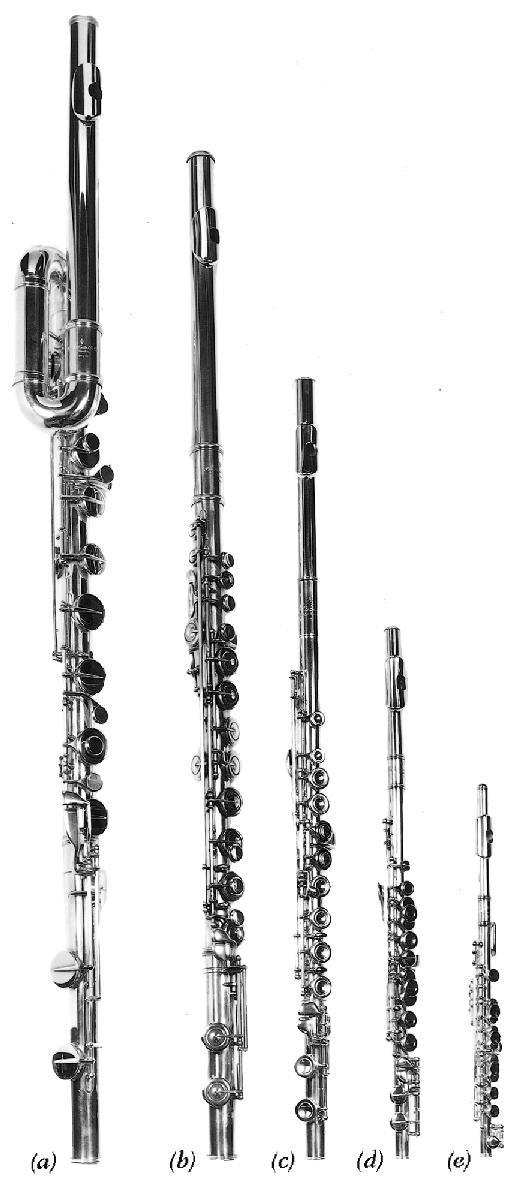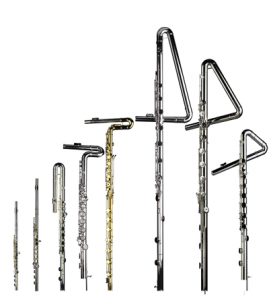
Concert Flute
When we think of flutes, we think of the common concert flute – silver, about 67 cm (26 inches) long, pitched in the key of C.
That’s just the start of the flute family, albeit the most familiar. If we start at the very short end, we have the piccolo. With ‘piccolo’ meaning ‘little’ in Italian, the full name is really the piccolo flute, but it’s most commonly just shorted.

Piccolo and Concert Flute
The modern piccolo can be made of silver, as shown here, or made of wood. It was first mentioned in flute method books by the 1740s but it was Beethoven who confirmed the instrument as part of the orchestra by including it in his Egmont Overture and in Symphonies 5, 6, and 9. The instrument plays an octave above the concert flute.
Ludwig van Beethoven: Symphony No. 6 in F major, Op. 689, “Pastoral” – IV. Thunder-storm: Allegro (Slovak Radio Symphony Orchestra; Michael Halász, cond.)

Modern orchestral flutes by Rudall, Carte & Co.: (a) bass in C; (b) alto in G; (c) concert in C; (d) treble in G; (e) piccolo in C
In his Thunderstorm movement, the piccolo provides a sharp driving sound, particularly around 02:15.
The third flute, called that because it’s pitched a minor third above the concert flute and was used by Mozart in Abduction from the Seraglio, by Beethoven in Symphony No. 9, Tchaikovsky in The Nutcracker, and in modern flute choirs.
Continuing down, we have the flûte d’amour, pitched a minor third below the concert flute. Verdi used them in Aida, but, by that time, the flute d’amour was so rare, they had to be specially made. It has really vanished from the modern orchestra.
The alto flute is pitched in G, a 4th below the concert flute. At this point, the flute is getting too long to use the standard fingering, so the mechanism had to be altered to bring the keys within reach. Twentieth-century composers loved its melancholic sounds and it was used in pieces such as Stravinsky’s Rite of Spring and Holst’s The Planets, as well as by many avant-garde musicians. This concert for alto flute and harp gives an indication of that sound.
Sweet Dreams – O Beloved – Beautiful Love Song – Best Alto Flute & Harp Music Instrumental Solo

Alto, bass, upright bass, contra’alto flute, contrabass, and subcontrabass flutes by Eva Kingma
There is no tenor flute – we move directly to bass and contra bass flutes. Now, the problem of length is solved by a change in the format of the flute – the flute doubles back on itself to take up space.
When you get beyond the bass flute, it’s no longer possible for the player to support the flute and the very lowest pitched flutes are played standing up, with the head joint at 90 degrees to the flute body.
In this Texas flute choir concert, we can see all varieties of flutes, including that upright flute standing at the back.
Brazos Breeze Flute Choir Concerts on Carter Creek
As you watch the flutists play, notice their hands and how, for the bigger instruments, they have to hold the instrument differently, particularly for the very large instruments in the front row on the left.
For more of the best in classical music, sign up to our E-Newsletter




Hi, I noticed a bass flute (you have diagram picture of it on this site) and I’ve seen it played by artists on you-tube. One of these artists is Geni Skendo Bass Flute http://www.GeniMusic.com I was wondering why bass flutes aren’t made this way anymore. These are awesome. In my researching, it appears that these flutes were made by Rudall & Carte a long time ago. Personally, I play in a flute choir and I love the sound of the bass flute but don’t like the candy cane look or the feel. I play the alto flute straight and find it very comfortable and the sound is wonderful. I tried the curved head but didn’t like it either (like the bass candy cane head). I could never get to liking either curved head joints. So I guess, my question to you is why did Rudall & Carte stop making this wonderful flutes. Also found YouTube of Frank Wess’ Bass Flute https://www.youtube.com/watch?v=a3IMNl7eXYM I hope you listen to these to see what I mean and hopefully these wonderful instruments can get a comeback. Thank you for your time.
Brilliant article. Thank you. One Flute left out was the Soprano Flute in Eb, which several Composers used in their scores from about 1860 onwards.